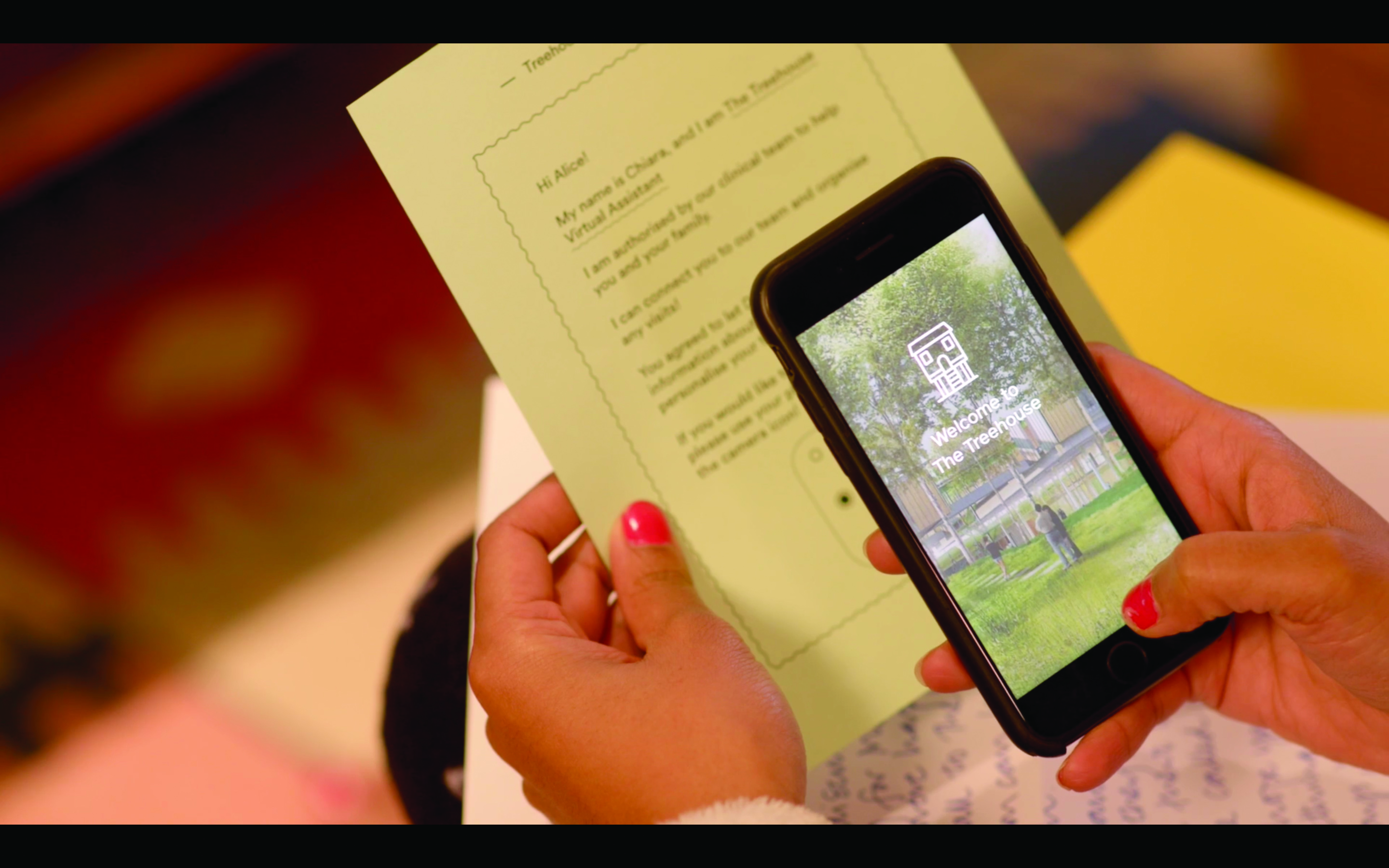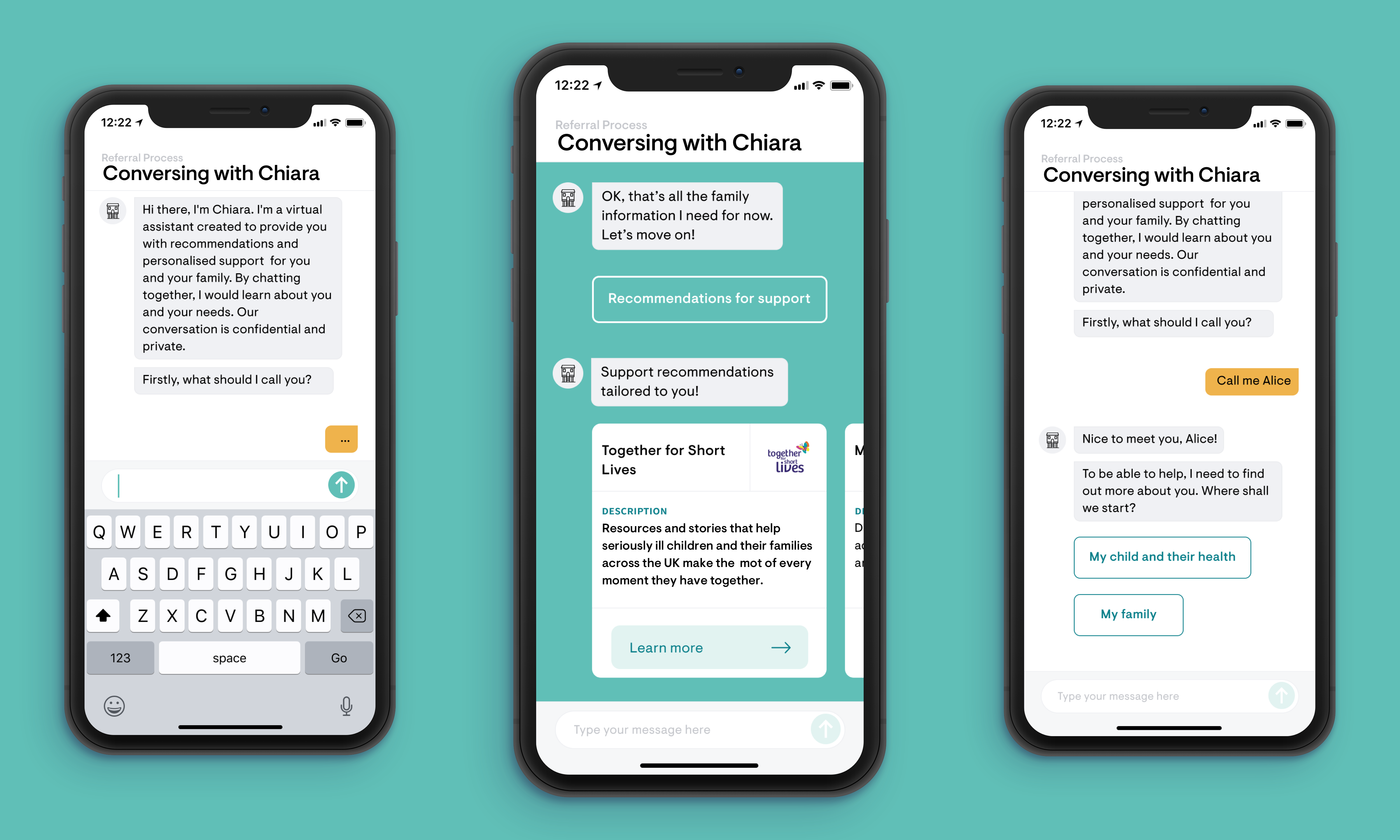Chiara
Materialising the future of care through film and technology

Background
For families caring for a child with a life-limiting or life-threatening illness, life can be incredibly difficult. The experience of parents who may give birth to a child with a congenital or inherited disease, or watch as their otherwise healthy child becomes ill with cancer, immediately puts them on the fringes of society. They can become isolated, separated from ‘normal’ life, with back-to-back hospital consultations and appointments, with huge pressures on family cohesion between partners and other children.
For many families, the appearance of a hospice service is a terrifying sight: signalling the end of their child’s life, the end of hope. Yet when they do bravely enter one, many are surprised to find that their life-affirming and supportive environment makes such a positive impact on their lives.
It is within that tension between being stuck in a closed loop at home, where families care for their child around-the-clock, and being included and supported in a holistic environment such as a children’s hospice, that we wanted to investigate with our second prototype. Our biggest motivator to develop a prototype was uncovered early in our research and definition phase, where so much of the hospice service relied on parents coming through the doors of the hospice in the first place.
Existing organisations already struggle to engage with families, to find them, and support them in a way that is meaningful for them in their journey. The teams working on the Seragnoli hospice equally identified in our user journey mapping work that the ‘onboarding’ to a hospice represented a pivotal moment for families. So much relied on it.
So this prototype represented a tangible way to present how these barriers could be overcome with the explicit use of technology. Framed slightly ahead of the current capabilities of technology – it presents a vision of the future. A future that our hospice partner, Seragnoli foresees with their hospice, to connect and support families through innovative technologies, responding to their unique needs.
Chiara is an prototype digital platform, providing parents with personalised information they might need to get the right support from the right person, at the right time. Chiara responds to families’ needs to find appropriate, actionable information and support when they are caring for their child at home. We prototyped this tangible vision of the future through a ‘design fiction’ film and a functional, supportive chatbot that can help families at home to care for their child.
Our aim
We wanted to develop Chiara as a ‘design fiction’ film; telling the story of how intelligent, supportive digital tools can help families at home to care for their child. The narrative film would incorporate elements of the prototype user interface (UI) that illustrated not only the technology itself, but how it will be incorporated into the hospice service with a focus on the ‘Awareness and referral’ and ‘First visit’ phase. We believe there is great scope for an artificial intelligence (AI) assistant to support families at these very early stages. We believe that the ability of such an AI agent would be feasible within the next few years.
As a healthcare innovation lab, using technology and design to improve health outcomes is at the core of the Helix Centre. We view technology as an enabler and know that it has the potential to empower users through autonomy. It enables the customisation of products/services; helps with decision-making; aids/supports medical therapies; can monitor, gather and analyse data; can help facilitate better communication; helps maintain a normal life for people, and can help people with orientation and/or essential logistics.
When discussing our starting points – scenarios and ideas – with hospice leaders, it was clear that there was a demand for such an approach. Sue Hogg, clinical director at CHAS in Scotland said that when it comes to engaging with a hospice for the first time, “parents say: ‘How do I navigate my way? Without asking someone that might commit me. How do I find out, do my own fact finding first?’”

What we did
Our goal from the beginning of the project was to develop tangible examples of technology that supported children’s and families’ needs, and also technology that provided a vision of the (near) future for the Seragnoli children’s hospice. Chiara was designed to provide that vision. But rather than presenting a functional prototype of the guide in isolation, outside of its intentional context, we wanted to show how its applications were rooted in the lives of families who would ultimately be using the service. We made a design fiction film of the prototype to achieve this.
Design fiction is about storytelling through and with designed objects. The stories provide context and meaning and bring people and social elements together to the stage, while the objects represent possible ways in which the envisioned technology, product or service is embodied and used. Design fiction is mostly firmly rooted in the here and now, but adds a layer of (near) future to it, thus blurring the boundaries between realism and fiction. Our film used pre-existing real world knowledge and information - for example around responding to a crisis at home - and combined with aspects of technology that are just outside of our grasp, to see what tensions, unintended consequences or positive opportunities may emerge.
Through our research phase - which included user interviews with families and shadowing professionals - we identified a number of goals for supporting families. We knew we needed to provide tailored recommendations for support groups and resources based on the specific needs and context of families. Secondly, we wanted to tailor information at a national level, which meant suggesting suitable children’s hospices, aiming to expedite families’ paths to the right facility. Lastly, we wanted to facilitate connections between families and professionals, as well as linking them to other families and services within the children’s hospice network.
Through our prototyping phase, we learnt that families could find useful a virtual assistant in the referral process to the children’s hospice. We know from our research that the systems of referral and engagement are fragmented. The clinical side is well managed, but families miss other things on the personal aspect like childcare, education, emotional support, bureaucracy and benefits. Chiara is a conversational agent that could help families in the referral process to the hospice, during their stay and after death, for bereavement. Ultimately, we felt Chiara could be the single touchpoint that helps the family navigate everything around their hospice care.
What comes next
Chiara provided us with two major insights. Firstly, presenting a design prototype as film, with the associated emotional attachments that come from telling a story of a family facing a crisis, effectively revealed the complexities and realities of supporting people with technology. There is no ideal scenario or hypothetical situation for technology to be used, but the film showed how nuanced experiences could be expressed and critiqued. This can only benefit the design process, enabling us to better understand the motivations and needs of families. The process of making was as important as the outcome. We were building to learn.
Secondly, by projecting a product into the near future, we avoided some of the early barriers in development that usually accompany the use of emerging technologies. The use of a chatbot with such a high level of learning takes certain things for granted: Chiara knew a lot about the family before they started talking, as we assumed that clinical records and private information could and would have been consented earlier, outside the scene. This was raised as a particularly problematic point of the scenario which validated the purpose of generating a realistic scenario in the first place. Our challenge now is to try and bring the Parent’s Guide closer to reality, to really see where ‘the rubber meets the road’ when it comes to digital services for hospice care.
Our prototype is driven by human needs and wants. Families need to feel connected and supported, but they don’t want to feel patronised by faceless technology. The challenge will be to balance both the need of a hospice to widen its care offering, while responding to the complex needs of those families who will ultimately use the service.